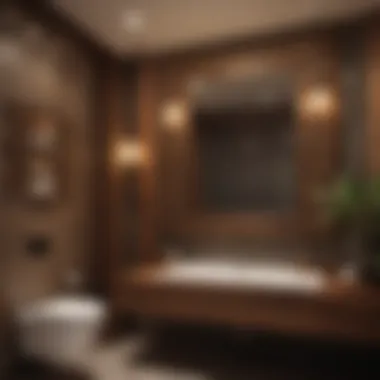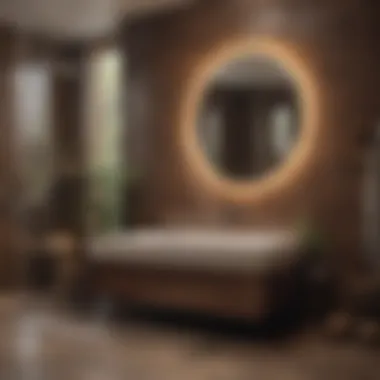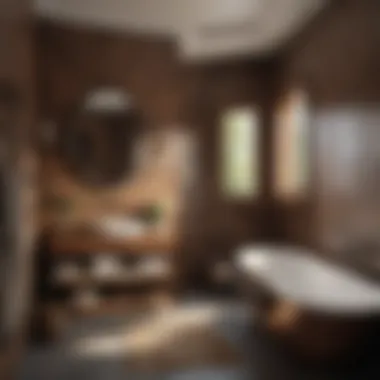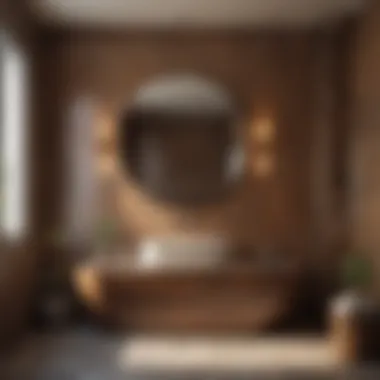Elegant Brown Bathroom Design Ideas for Your Home


Intro
In the realm of interior design, color plays a pivotal role in shaping moods and experiences. When it comes to bathrooms, a space often associated with tranquility and relaxation, the choice of hues can deeply affect the ambiance. Brown, though sometimes overlooked, holds a unique place in this palette. Its earthy tones can evoke warmth, stability, and even a touch of luxury. This guide will delve into the elegant and stylish ways to incorporate brown into bathroom designs, providing homeowners with a wealth of ideas that harmonize aesthetics with practicality.
Trending Styles
Modern Minimalism
Among contemporary design trends, modern minimalism stands out for its clean lines and simple forms. When brown is introduced within this framework, it offers a striking complement to the typically stark features of minimalism. Think sleek brown wood cabinetry, paired with white or light beige tiles. This contrast not only enhances visual appeal but also brings a sense of warmth to an often chilly aesthetic.
To execute this look effectively, consider these elements:
- Materials: Opt for materials like walnut or teak that showcase their natural grain.
- Accessories: Choose minimalistic fixtures in brushed nickel or matte black to maintain a streamlined appearance.
- Textures: Incorporate subtle textures through fluffy towels or woven baskets to soften the overall feel while keeping it modern.
Cozy Rustic
For those who prefer a more welcoming vibe, the cozy rustic style might be ideal. Imagine a bathroom that feels like a sanctuary, filled with the scents of cedar and pine. Brown plays a starring role here, from wooden beams overhead to earthy clay tiles underfoot. This style can be achieved by using reclaimed wood for vanities or sliding barn doors, which creates an organic connection with nature.
Key elements for cozy rustic design:
- Nature-inspired accents: Use stones and plants for decor to bring the outdoors inside.
- Color variations: Mix different shades of brown to create depth; think deep chocolate paired with soft tan.
- Warm lighting: Consider pendant lights or sconces with amber shades to create a gentle, inviting glow.
Color Palettes
Calming Neutrals
Brown can easily intertwine with other neutral tones for an overall calming effect. Consider pairing it with soft whites, light grays, or even muted greens. This combination can make a space feel more expansive and still maintain that comforting essence. For a more cohesive look, paint the walls a soft taupe and select darker brown wood for cabinetry.
- Accent colors: Introduce pops of color through accessories — soft golds or jades pair beautifully with brown.
- Tile choices: Hexagonal tiles in a neutral palette can add a modern twist while emphasizing brown’s rich hues.
Bold Accents
If you're feeling adventurous, explore the option of using brown as a bold accent rather than a dominant color. Picture a bathroom crowned with rich brown walls against a backdrop of vibrant decor — perhaps teal towels or a bright yellow rug. This approach provides a stunning visual contrast that can make the space truly captivating.
- Feature walls: Designate one wall to showcase deep brown wallpaper with intricate patterns.
- Decorative items: Use small accents like a brown soap dispenser or a ceramic vase to tie the room together.
"When it comes to design, it's about finding balance. Brown offers a foundation, while brighter colors can dance around it, creating an engaging atmosphere.”
By exploring these styles and palettes, you'll find many innovative ideas for creating a bathroom that not only reflects your taste but also serves as a serene retreat. The elegance of brown tones, when executed thoughtfully, has the power to elevate a simple bathroom into a sophisticated haven.
The Significance of Color in Bathroom Design
When it comes to crafting an ideal bathroom, the significance of color cannot be overstated. Much like a painter selects the right palette for a masterpiece, homeowners and designers need to pick colors that resonate with the intended atmosphere of the space. Brown, in particular, has found its niche as a go-to color in modern bathroom design. It’s not merely a hue but a tone that creates depth and invites a sense of warmth.
The bathroom is often perceived as a sanctuary, a personal retreat where relaxation reigns supreme, and color plays a crucial role in shaping this experience. Choosing the right shade of brown can make all the difference, influencing mood, perception of space, and even the overall aesthetic. This earthy color has the potential to ground a design, fostering feelings of security and tranquility.
"Color is the keyboard, the eyes are the harmonies, the soul is the piano with many strings." - Wassily Kandinsky
Moreover, the significance of color extends to practical applications, such as how dark or light colors can affect the perceived size of a bathroom. Light shades, including soft taupes or creamy browns, can help smaller bathrooms feel more spacious, while deeper tones can add an intimate aura. Thus, understanding color dynamics isn’t just about beauty; it’s about harmonizing function and form.
Understanding the Psychology of Brown
Diving deeper into the psychology of brown reveals a fascinating layer to its use in bathroom design. Brown is often associated with a sense of stability and reliability. It's a color that evokes feelings of comfort, much like your favorite worn-out sweater. In the realm of interior design, brown can symbolize a connection to nature, reflecting the groundedness of tree trunks or rich soil and establishing a comforting environment.
Using brown in the bathroom can create a sense of serenity. It is not vibrant or distracting, but rather soothing to the eyes. This is important in a space dedicated to unwinding and self-care.
Additionally, the choice of brown can convey a luxurious feel. Think of deep chocolate browns paired with gold accents or rustic woods against creamy whites. Such combinations can elevate the bathroom from a mere utility space into a personal spa-like retreat.
The Role of Earthy Tones in Creating Calm Spaces
Earthy tones, including varieties of brown, play a pivotal role in establishing calmness in any environment. They echo elements from nature, which can instinctively trigger a sense of peace and balance. When these tones are incorporated into bathroom design, they help in creating an atmosphere that promotes relaxation and introspection.
Imagine a bathroom adorned with warm brown tiles that replicate the look of natural stone or wooden elements alongside beige walls. Such a combination can soften the harshness often associated with tile and metal fixtures typically found in bathrooms, allowing the space to breathe and feel inviting.
Key Benefits of Earthy Tones:
- Promote Relaxation: These colors can reduce stress levels and invite calmness.
- Timeless Appeal: Earthy shades rarely go out of style, making them a long-lasting choice.
- Versatility: They blend seamlessly with a variety of other colors and decor styles, from rustic to contemporary.
By choosing earthy tones like brown, homeowners craft a deliberate narrative within their bathrooms, one that frames the space as a restorative haven rather than just an everyday utility. Ultimately, brown’s significance in bathroom design transcends mere aesthetics; it fosters a holistic experience that embraces tranquility and thoughtful living.
Choosing the Right Shade of Brown
When diving into the realm of bathroom design, the shade of brown you select can lay the groundwork for the entire atmosphere. It’s not merely about picking a color; it's about understanding how each tone can create a sense of warmth, comfort, or sophistication. Features such as the bathroom's size, lighting, and even personal taste play significant roles in this choice. A well-chosen brown can serve as a blank canvas for other elements or stand alone as a statement of style. Making the right choice can harmonize the space and elevate it into a tranquil retreat.
Exploring Warm vs. Cool Undertones
Brown hues are surprisingly versatile, mainly when one takes into account the balance of warm and cool undertones. Warm brown shades tend to carry notes of red or orange. They are inviting and comfortable, a perfect fit for a cozy, rustic feel. Imagine a rich chestnut or a deep tawny; these tones can wrap the space in a sense of welcome.
On the other hand, cool undertones allow for a more contemporary touch. Shades like ash brown or slate add a crispness that can feel stylish and smart. This type of brown tends to evoke a clean, sophisticated vibe. Ultimately, knowing the underlying tone can be crucial. For instance, in a sunlit bathroom, you might want to lean toward cooler shades to offset the heat of natural light, whereas in a dimly lit area, warmth could bring life and depth.


Pairing Brown with Other Colors
Color is like a conversation; it interacts and flows. When pairing brown with other colors, there are significant methodologies to consider. This interaction not only defines your bathroom aesthetic but also affects the overall feel of the space.
Complementary Color Schemes
One of the most well-known methods involves complementary color schemes. Pairing brown with its complementary color, say a soft blue or mint green, can create a visually pleasing dynamic. This pairing is particularly beneficial in smaller spaces, where lighter colors can help lift the atmosphere, balancing out the heaviness that darker browns might impart.
The key characteristic of this scheme is its ability to reduce the weight of darker tones while enhancing the richness of brown. A unique feature here is that, unlike most color combos, complementary colors can come off as serene. The cool blues can soften and harmonize, effectively making the bathroom feel more expansive. The downside may be that, if not executed carefully, the color contrast could tip the space from elegant to chaotic, disrupting the desired tranquility.
Contrasting Colors for Visual Interest
Conversely, contrasting colors create a bold statement, drawing attention within your space. Darker browns can pair with vibrant yellows, rich greens, or even vivid reds to establish a lively atmosphere that sparks visual interest. This choice is often favored for bathrooms that seek to stand out and be more than just a functional space.
A bright splash of color against a dark backdrop can create a dramatic, almost theatrical effect, engaging any onlooker. This contrasts well with the soft, matte textures of brown materials. However, the challenge here could be in maintaining a sense of balance. Too much contrast may lead to a jarring environment rather than a relaxing retreat.
In summary: Choosing the right shade of brown is a pivotal element in bathroom design, as it influences other elements and overall atmosphere. Understanding undertones is critical and how they pair with other colors can either accentuate elegance or cause disarray. Getting this right is key to creating not just a bathroom, but a sanctuary.
Incorporating Brown in Bathroom Fixtures
The infusion of brown tones into bathroom fixtures offers a way to harmonize functionality with aesthetics. This earthy color evokes warmth and comfort, serving as a grounding element in personal spaces. By integrating brown in your bathroom fixtures, you're not just enhancing the visual appeal; you’re creating a serene atmosphere where relaxation takes center stage. The richness of brown can complement various bathroom designs, from rustic to modern, making it a versatile choice for homeowners. Let's dive deeper into how you can select and utilize brown bathroom furniture and fixtures effectively.
Selecting Brown Bathroom Furniture
Vanities and Storage Solutions
Choosing the right vanity and storage solutions is crucial in achieving a well-designed bathroom that balances both style and storage capacity. The advantage of brown vanities lies in their ability to blend seamlessly with a variety of decors. They might come in rich mahogany or lighter oak finishes, offering versatility.
A standout characteristic of brown vanities is their durability; hardwoods often resist wear while providing a timeless aesthetic. The unique feature to consider is the charming grain patterns that vary from one piece to another, lending character and individuality to each unit. Many modern homeowners prefer open shelving options that allow for display while keeping essentials neatly stored away. This added accessibility can make routine tasks much smoother, creating an efficient workflow in the bathroom. However, one potential downside is that darker shades might require more maintenance as they tend to show dust and water spots more visibly.
Seating Options with Brown Tones
When it comes to seating in a bathroom, incorporating seating options with brown tones may enhance both style and functionality. This could include anything from a rustic wooden bench to a plush, upholstered stool in a rich chocolate hue.
The key characteristic of brown seating is its ability to provide warmth and invite relaxation, transforming your bathroom into a mini sanctuary. Opting for seating with storage capabilities adds practicality, especially in smaller spaces. What makes these pieces particularly appealing is how well they harmonize with the rest of your fixtures. They can act as a beautiful contrast against lighter tiles or paint colors, providing visual interest without overwhelming the space. However, it’s essential to be mindful of the proportion—too much bulky furniture may cramp the area and reduce its serene effect.
Choosing The Right Fixtures and Fittings
Faucets and Showerheads
The selection of faucets and showerheads plays a pivotal role in defining the overall look and feel of your bathroom. Choosing brown or bronze finishes can add an earthy, sophisticated touch.
A significant benefit of selecting fixtures in these tones is that they complement the brown hues in your design while also standing out as statement pieces. Their unique textures and finishes can subtly reflect light, enhancing the bathroom's visual appeal. Practicality comes into play as well—many modern fixtures feature finishes that resist tarnishing and are easy to clean, making them a smart choice for busy households. One thing to keep in mind, though, is the compatibility with plumbing, so ensure any fixtures fit well with existing setups.
Lighting that Complements Brown Decor
Choosing the right lighting can amplify the beauty of brown decor. The warmth of brown tones calls for soft, diffused lighting that contributes to a cozy atmosphere. Consider fixtures that incorporate materials like wood or bronze to harmonize with your brown theme.
Highlighting the unique feature here is the ability of proper lighting to create ambient layers. By using different fixtures at varied heights, you can achieve a sense of coherence in your design while enhancing functionality. Moreover, warm LED bulbs can soften the overall tone, making the space feel inviting. However, be cautious of over-lighting, which might clash with the tranquility you seek in a brown-themed bathroom.
"Brown is versatile and adaptable; it can invoke rustic warmth or modern elegance, depending on its application."
In wrapping up this segment, integrating brown in bathroom fixtures and fittings is a thoughtful way of achieving a cohesive design. The balance between functionality and style is pivotal in creating a peaceful retreat that many seek in their home environments. Explore the options available and consider how each element can work together to enhance your unique bathroom vision.
Design Styles that Embrace Brown
In the realm of bathroom design, choosing a style that harmonizes with brown hues opens doors to a plethora of aesthetic possibilities. Brown embodies warmth and sophistication, making it an ideal choice for a variety of design preferences. By exploring different styles that incorporate brown, homeowners can create spaces that are not only functional but also inviting and refreshing to the senses. The core elements of these styles—such as texture, material choice, and color pairings—offer vital insights into how brown can become a central theme in bathroom aesthetics.
Rustic Bathroom Inspirations
Rustic bathrooms draw from natural beauty and simplicity, creating a welcoming vibe that envelops you as soon as you step inside. The integration of earthy tones, particularly shades of brown, lays the groundwork for this style, evoking a sense of tranquility.
Use of Natural Materials
One of the hallmarks of rustic bathrooms is the use of natural materials. Wood, stone, and clay come together to craft a space that feels grounded and serene. Wood finishes, in particular, shine in a rustic setting; they not only enhance the warm tones of brown but also bring in a sense of organic authenticity. This choice is often beneficial since it fosters a connection to nature—imperfections in the wood or tile, such as knots or textures, tell a story.
However, one might find the maintenance aspect tricky. Natural materials can be susceptible to moisture damage, so it’s crucial to select quality finishes that endure humidity.
Creating a Cozy Atmosphere
Creating a cozy atmosphere in your bathroom can significantly enhance your daily routine. Brown tones naturally offer a warm and inviting feeling. You might consider incorporating soft textiles and warm lighting—like sconces or candles—to enrich the ambient feel.
The charm of this approach lies in layering elements; think plush towels in rich browns, alongside wooden shelves and earthy clay pots. This mix not only makes the space functional but also draws people in. However, striking the balance between cozy and cluttered can be a bit of a tightrope walk, requiring careful consideration of layout and decor.
Modern Minimalism with Brown Accents
When considering modern minimalism with brown accents, you focus on simplicity yet aim for impactful design. This juxtaposition highlights brown as a significant element without overwhelming the other design features. The clean lines and uncluttered spaces often found in modern design harmonize exceptionally well with deep browns or lighter beige tones, leading to a sleek yet warm bathroom environment.
Minimalist designs require a careful selection of materials and textures to ensure visual interest. Utilizing matte finishes or polished surfaces can create striking contrasts, allowing brown accents to pop against the backdrop of a neutral palette.


Eclectic Designs Featuring Brown
The eclectic style thrives on mixing and matching. In terms of incorporating brown, it encourages bold choices and thoughtful combinations that reflect personal style. To achieve a coherent look amidst the variety, one must pay attention to the themes and elements being juxtaposed.
Mixing Patterns and Textures
Mixing patterns and textures brings vibrancy and individuality into the bathroom. Consider pairing a geometric patterned curtain set with a rustic woven rug. Brown can serve as a unifying color—common in the threads of the fabric or as an accent in tiles. This variety sparks visual interest and keeps the space from feeling monotonous.
While embracing an eclectic approach, the potential downside is achieving a cohesive look. Careful attention must be paid to not go overboard with clashing patterns, which can make the space feel chaotic rather than inviting.
Global Influences in Brown Decor
Incorporating global influences into brown decor adds depth and character. Think of Moroccan tiles, Indian textiles, and Japanese simplicity—all beautifully embracing shades of brown. Each cultural influence tells a unique story and contributes to the bathroom's overall ambiance.
When blending these elements, you create not only a visually appealing space but also one that feels enriched by the global spectrum. The challenge here lies in harmonizing different styles without diluting their individual essence, thereby retaining the personality of each piece while crafting a unified narrative through brown.
In summary, utilizing brown hues in various design styles can yield profoundly rewarding results in bathroom aesthetics, making these spaces feel both elegant and inviting.
Materials to Consider When Designing with Brown
When it comes to designing a bathroom that incorporates brown tones, the choice of materials plays a central role in achieving both aesthetic appeal and functionality. Brown, with its various shades and undertones, can create a warm, inviting atmosphere. However, selecting the right materials can elevate that ambiance to something truly remarkable. From wood finishes to textiles, each element contributes differently, affecting durability, style, and overall maintenance. This section breaks down the essential materials one should consider when aiming to harmonize brown hues in the bathroom space.
Wood Finishes in Brown Bathrooms
Wood finishes are an excellent way to introduce brown into a bathroom design. They evoke a sense of nature and warmth that can make a small or large area feel more grounded. Different types of wood can bring varying qualities; for example, walnut offers richness with its deep, dark shades, while oak can provide a lighter, more rustic feel.
Wood also allows for versatility in design. Depending on how it’s finished, it can go from sleek modern to cozy farmhouse.
One must bear in mind the importance of treating wood to withstand humidity. That’s where finishes like sealants come in handy. They protect the wood from moisture, ensuring a long-lasting aesthetic appeal without the risk of damage.
Ceramic and Porcelain Tiles
Tiles are the unsung heroes in bathroom design, especially when you want to introduce brown tones through ceramic and porcelain options. These materials offer durability and versatility. With advances in design, tiles can mimic the look of natural stone or wood, enriching your bathroom’s overall character.
Diverse Textures and Patterns
Diversity in texture and pattern can significantly affect how brown tiles interact with light and space. For instance, a glossy beige tile may reflect light differently than a matte brown tile with a rough surface. This interplay enhances the visual interest in the room.
Incorporating patterned tiles can create striking focal points. Whether using subway patterns or intricate mosaics, patterns can break the monotony of flat surfaces. This unique feature adds layers to the ambiance, transforming a simple bathroom into a standout space.
However, it’s essential to choose textures wisely; some may require more upkeep than others, so a balance of style and practical consideration is key.
Durability and Maintenance
When choosing tiles, durability becomes paramount. Ceramic and porcelain tiles provide an excellent surface that can handle high moisture levels while requiring relatively low maintenance. They're resistant to stains and scratches, making them a top contender for bathroom flooring or walls.
The fact that these tiles can often be simply cleaned with a damp cloth and mild detergent adds to their allure. However, one must always consider the grouting, as it can be a challenge over time.
Ultimately, opting for durable tiles enriched with brown hues means starting off on a solid foot for both style and practicality.
Textiles in Brown Shades
Textiles are often overlooked, yet they wield a powerful influence in bathroom decor. Brown shades in towels, rugs, and curtains can soften hard surfaces, creating a warm vibe. This blending can make the space feel more cozy and inviting, encouraging relaxation during bath time.
Towels, Rugs, and Curtains
Choosing textiles like towels, rugs, and curtains in brown shades allows for a subtle infusion of color without overwhelming the decor. High-quality cotton or linen towels not only offer comfort but also exude a sense of natural elegance.
Rugs can further help in defining spaces, especially in larger bathrooms. A soft, textured rug in a rich chocolate brown can invite touch and comfort while being functional in terms of absorbing water.
Curtains in brown can frame the windows, adding depth and dimension to the bathroom. They can soften harsh light while enhancing the overall warmth of the space. On the contrary, lighter shades might offer an illusion of space, making it feel airier.
Using Fabrics to Enhance Style
Fabrics have this wonderful ability to enhance and tie together the various elements of a bathroom. Utilizing layers of textiles can add warmth and sophistication. For example, consider using brown tones alongside other colors to create visual harmony or contrast.
Additionally, fabrics with different prints and textures can add character to the design. From geometric patterns to florals, they can easily bring a refreshingly unique look. However, be mindful of fabric maintenance; while some materials may enhance aesthetic appeal, they might also require more upkeep, which should be regarded based upon your lifestyle.
Over all, materials play a significant role in how effectively brown is incorporated into bathroom designs, shaping not just style but also functionality. By carefully selecting wood finishes, ceramic or porcelain tiles, and textiles, one can create a harmonious bathroom environment that invites comfort and elegance.
Lighting Solutions that Enhance Brown Bathrooms
In the realm of bathroom design, lighting plays a pivotal role—not only in functionality but also in aesthetics. With brown hues often evoking warmth and earthiness, complementary lighting can intensify these feelings, creating an inviting atmosphere. Thoughtful use of light can accentuate the rich nuances of brown, highlighting textures and materials, while setting the overall mood of the space. Failing to consider lighting can lead to dull spaces where beautifully curated elements go unnoticed.
Natural Lighting Considerations
Natural light provides an unmatched advantage in any design setting, especially in bathrooms where it can enhance the beauty of brown tones. Sunlight spilling through a window can bring forth the vibrant undertones in wooden cabinetry or terracotta tiles, making fixtures come alive. Maximizing this resource is key; consider using frosted glass windows to promote privacy while still allowing light to filter through. A skylight is also an excellent addition for those seeking to bathe their bathroom in daylight while maintaining an intimate setting. Placement of mirrors to reflect incoming light can create the illusion of a larger space, amplifying that serene, open ambiance crucial in a bathroom retreat.
Artificial Lighting for Brown Hues


When natural light isn’t an option or to enhance evening settings, artificial lighting becomes essential. The depth of brown can sometimes absorb light, making a space feel smaller or overly shadowed. Thus, attention to artificial light sources is vital.
Types of Light Fixtures
Various types of light fixtures can complement brown hues effectively. Wall sconces, often placed near mirrors, can provide warm, directional light that keeps shadows at bay, enhancing facial features during tasks like grooming. The design of sconces varies—from rustic metal finishes that resonate with wooded accents to sleek, modern models that offer a more contemporary feel. A key benefit of wall sconces lies in their versatility; they can be positioned at eye level, drawing focus away from the darker elements of your design and ensuring a well-lit experience.
On the other hand, pendant lights or chandeliers can add a touch of elegance. They hang low and can provide a splash of formality. If you opt for glass fixtures with warm bulbs, you'll find they reflect and soften the brown tones beautifully, creating a harmonious glow throughout the space.
ul> li>Wall Sconces: Great for task lighting.li> li>Ceiling Mounts: Ideal for ambient light.li> li>Pendents: Adds elegance and sophistication.li> ul>
Layering Light for Ambiance
Layering light is about using multiple sources at varying heights to achieve a harmonious effect. For brown bathrooms, this technique can help balance shadows and enhance warmth. Consider mixing various types of fixtures—overhead lights for general illumination, then soft table or wall lamps for mood. Accent lighting, such as LEDs beneath cabinetry, can also offer soft glows that outline features and textures. This strategic placement of lights draws attention to key elements like artwork or plants, fostering a serene and inviting space.
Layering light also helps with functionality, providing enough brightness for daily routines while also allowing for a more relaxed environment when desired.
"The key is to balance brightness with warmth, ensuring that the beauty of brown is showcased rather than overshadowed."
Ensuring that your lighting approach is holistic will not only enhance the beauty of brown elements in your bathroom but will also elevate the entire experience—making every visit feel special.
Decorative Elements to Complement Brown
When it comes to designing a bathroom that's rich in brown tones, decorative elements play an indispensable role. These accents not only enhance the aesthetic appeal of the space but also serve to express individual style. Brown, being an earthy color, evokes a sense of warmth and comfort, and the right decorative choices can amplify these qualities.
Some specifics to consider include balanced compositions, layered textures and thoughtful arrangement. This section aims to shed light on key decorative aspects that integrate seamlessly with brown while offering unique character.
"Decorative elements become the thread that stitches the entire design together, making it cohesive and inviting."
Artwork and Accents
Framed Prints and Photography
Framed prints and photography are powerful tools in enhancing a brown-themed bathroom. Their versatility allows them to fit various styles, be it contemporary or rustic. Choosing the right images, especially those with earthy color tones or inspiring landscapes, can create visual interest and add depth.
One of the primary benefits of framed artwork is its ability to act as a focal point. A well-placed piece can draw the eye, diverting attention from less appealing design elements. On the flip side, there’s a risk of overwhelming the space if not balanced properly. Therefore, it's essential to choose prints that complement the brown hues rather than compete with them.
Another unique aspect of framed photography is the potential for personal expression. Customized pieces can tell a story, making the bathroom feel more like home. However, one must be cautious as moisture can damage certain materials, calling for protective measures.
Three-Dimensional Elements
Three-dimensional elements, like sculptures or wall hangings, can truly elevate brown bathroom designs. Unlike flat artwork, these features add an intriguing layer, creating a sense of depth and dynamism. Materials like wood or ceramic, which resonate with earthy tones, will fit right into the brown theme.
A key characteristic of three-dimensional decor is its multifaceted nature. They can be used to draw attention to certain areas or to unify disparate elements in a room. For example, hanging a wooden sculpture above a brown sink can create a cohesive look. However, one consideration is maintaining a balance; overdoing it can lead to visual clutter, overshadowing the core design.
Plants and Greenery
Choosing the Right Indoor Plants
Incorporating plants into brown bathroom designs can breathe life into the space. Plants like succulents or ferns complement earthy tones beautifully and can soften hard edges in decor. They are not just decorative but also bring fresh air into your bathroom.
A notable advantage of choosing the right indoor plants is their ability to create an organic feel. This brings a natural touch, promoting a tranquil ambiance that contrasts nicely with rich brown tones. However, it may require some trial and error to find plants that thrive in the often humid environment of a bathroom.
Placement for Visual Balance
Placement of plants is crucial in achieving visual balance. Positioning them at varying heights can create a layered look that draws the eye around the room. Potted plants on shelves or hanging planters can add interest without taking up valuable floor space.
One of the benefits of strategically placing greenery is its ability to break up monotonous brown tones, adding freshness to the design. However, one must ensure that they don't overcrowd the space. Overleafing can lead to a cluttered feeling, which can counteract the serene atmosphere brown aims to create.
In this way, the careful selection and placement of decorative elements not only enhance the visual appeal but also contribute to a cohesive and harmonious design that celebrates the beauty of brown in bathrooms.
Practical Tips for Designing with Brown
Brown can be a commanding color in bathroom design offering depth and warmth that’s hard to replicate with cooler shades. However, to truly harness its potential, one must be strategic about its implementation. This section shares practical tips on effectively integrating brown hues throughout your bathroom. From methods to create contrast and enhance visual interest to ensuring the balance and proportion of elements, these tips will help establish a space that resonates with both comfort and style.
Creating Contrast with Textures
Textures are like the musicians in an orchestra; they play vital roles in achieving a harmonious bathroom ambiance. With brown as the nucleus, layering different textures can add dimensions that transform a flat space into a tactile experience.
Utilizing varied materials is key:
- Wood: Incorporate oak or walnut for cabinetry or flooring to amplify warmth. Avoid glossy finishes; instead, consider a matte texture that adds subtle elegance.
- Tiles: Choose ceramic or porcelain tiles in earthy tones. A rough-hewn tile can contrast nicely against the smoothness of brown wooden accents.
- Fabrics: Soft textiles such as cotton towels or a plush rug in complementary shades enhance livability. Think about how the friction of different textures interacts with your feet and eyes.
Combining these surfaces can create a striking contrast that will keep the eye moving through the space. As they say, variety is the spice of life, and this certainly applies when designing with brown.
Balance and Proportion in Brown Spaces
When it comes to maintaining balance and proportion in a brown-themed bathroom, the rules of visual weight come into play. Brown is inherently grounding but can also weigh a space down if not contrasted correctly. To avoid a closed-in feeling, consider the following:
- Light and Airy Elements: Pair darker browns with light-colored fixtures, such as a white porcelain sink or brass accents that gleam. These lighter elements can act as anchors that lift your design.
- Avoid Overcrowding: Minimalism can go a long way. If the cabinetry is a rich chocolate brown, then opt for lighter bath linens or artwork to avoid overwhelming the senses.
- Strategic Placement: Think about proportion in your choice of decor. Large mirrors can reflect light and offer an illusion of space, making the area feel larger, even if you are working with a smaller size room.
Striking the right balance involves trial and error, but with careful consideration of each element's proportion to the whole, you can design a bathroom that feels both inviting and organized.
"The secret of good design is in the details; never underestimate the power of balance in color and texture."
By implementing these practical tips, homeowners can create a brown bathroom that is rich in personality while remaining serene, striking a perfect balance between style and comfort.















